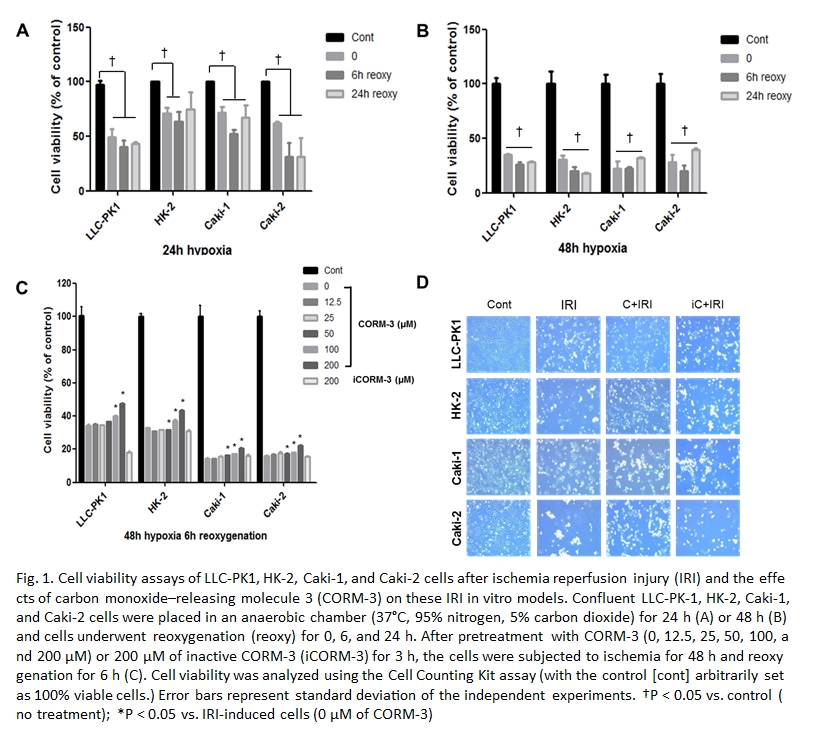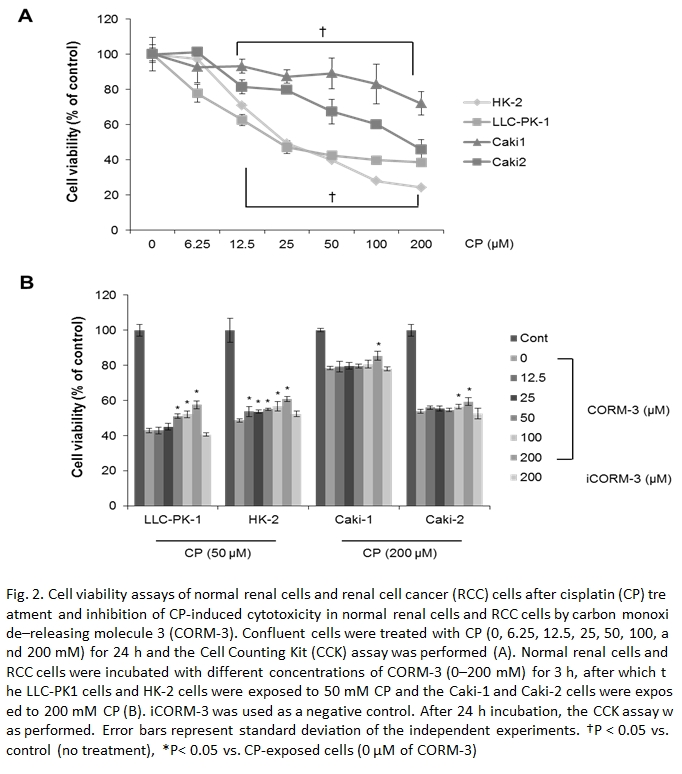Renoprotective Effects of Carbon Monoxide–Releasing Molecule 3 in Ischemia Reperfusion Injury and Cisplatin-Induced Toxicity.
1Urology, Urological Science Institute, Yonsei University College of Medicine, Seoul, Republic of Korea
2Transplantation Surgery, Research Institute for Transplantation, Yonsei University College of Medicine, Seoul, Republic of Korea
Meeting: 2017 American Transplant Congress
Abstract number: D58
Keywords: Renal ischemia
Session Information
Session Name: Poster Session D: Ischemic Injury and Organ Preservation Session III
Session Type: Poster Session
Date: Tuesday, May 2, 2017
Session Time: 6:00pm-7:00pm
 Presentation Time: 6:00pm-7:00pm
Presentation Time: 6:00pm-7:00pm
Location: Hall D1
Background: We investigated the effects of a soluble carbon monoxide–releasing molecule (CORM) in cisplatin-induced cytotoxicity and ischemia reperfusion injury (IRI) in vitro.
Methods: The effects of CORM-3 (12.5–200 mM) were assessed in normal kidney epithelial cells (HK-2, LLC-PK1) and renal cancer cells (Caki-1, Caki-2) subjected to cisplatin (50–200 mM) or IRI. To induce IRI, cells were placed in an anaerobic chamber (37[deg]C, 95% nitrogen, 5% carbon dioxide) for 48 h. Cells were transferred to complete medium and incubated at 37[deg]C, 5% carbon dioxide for 6 h. Cell viability (CCK assays), TNF-a mRNA levels (quantitative reverse-transcriptase PCR), and protein expression of C-caspase 3 and oxidative stress markers (including Erk1/2, JNK, and P38; western blot) were assessed.
Results: Viability after IRI was approximately 40% of control. Protective effects of CORM-3 in the IRI model were dose-dependent. Cell viability was 40% recovered in 200-mM CORM-3-pretreated cells compared with control.  The protective effects of CORM-3 in cells exposed to cisplatin for 24 h were weaker than in the IRI model.
The protective effects of CORM-3 in cells exposed to cisplatin for 24 h were weaker than in the IRI model.  TNF-a mRNA was induced by stimulated IRI or cisplatin exposure; CORM-3 pretreatment attenuated the rise in TNF-a mRNA. IRI or cisplatin-induced activated oxidative stress markers decreased in CORM-3 pretreated cells. CORM-3 reduced expression of the apoptotic marker C-caspase 3.
TNF-a mRNA was induced by stimulated IRI or cisplatin exposure; CORM-3 pretreatment attenuated the rise in TNF-a mRNA. IRI or cisplatin-induced activated oxidative stress markers decreased in CORM-3 pretreated cells. CORM-3 reduced expression of the apoptotic marker C-caspase 3.
Conclusion: Our data demonstrate the protective effects of CORM-3 in cisplatin-cytotoxicity and IRI in both normal kidney cells and renal cancer cells in vitro. CORM-3 exerts these effects by ameliorating inflammatory and oxidative stress pathways.
CITATION INFORMATION: Yoon Y, Lee H, Huh K, Kim M, Kim S, Kim Y, Han W. Renoprotective Effects of Carbon Monoxide–Releasing Molecule 3 in Ischemia Reperfusion Injury and Cisplatin-Induced Toxicity. Am J Transplant. 2017;17 (suppl 3).
To cite this abstract in AMA style:
Yoon Y, Lee H, Huh K, Kim M, Kim S, Kim Y, Han W. Renoprotective Effects of Carbon Monoxide–Releasing Molecule 3 in Ischemia Reperfusion Injury and Cisplatin-Induced Toxicity. [abstract]. Am J Transplant. 2017; 17 (suppl 3). https://atcmeetingabstracts.com/abstract/renoprotective-effects-of-carbon-monoxide-releasing-molecule-3-in-ischemia-reperfusion-injury-and-cisplatin-induced-toxicity/. Accessed December 19, 2025.« Back to 2017 American Transplant Congress
